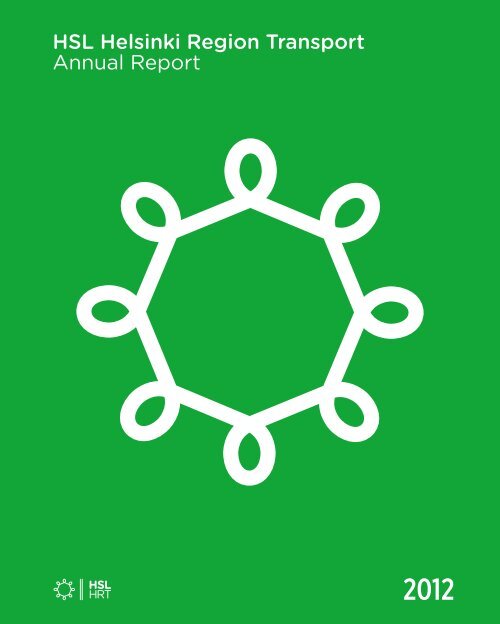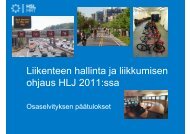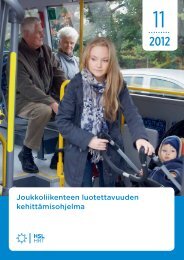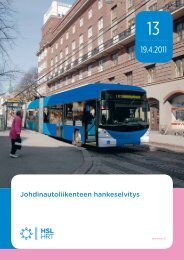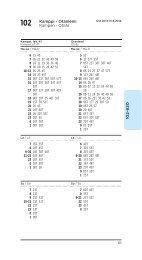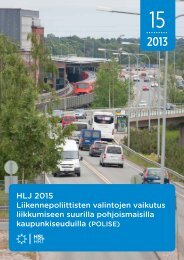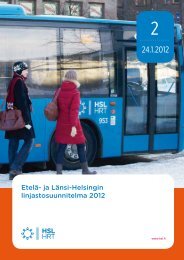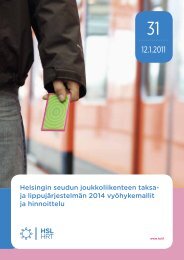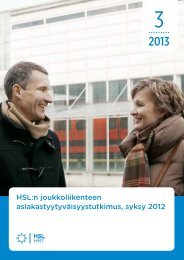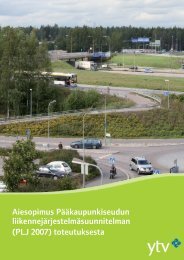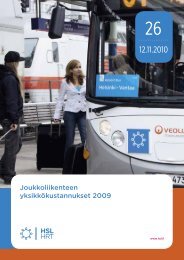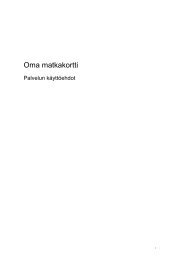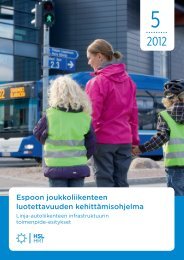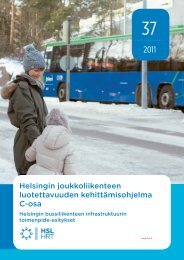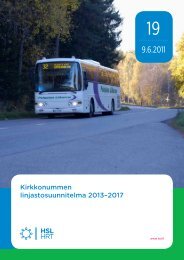Annual Report 2012 - HSL
Annual Report 2012 - HSL
Annual Report 2012 - HSL
You also want an ePaper? Increase the reach of your titles
YUMPU automatically turns print PDFs into web optimized ePapers that Google loves.
<strong>HSL</strong> Helsinki Helsingin Region seudun Transport liikenne<br />
Vuosikertomus<br />
<strong>Annual</strong> <strong>Report</strong><br />
<strong>2012</strong>
<strong>HSL</strong> Helsinki Region Transport<br />
<strong>Annual</strong> <strong>Report</strong> <strong>2012</strong><br />
Content<br />
This is <strong>HSL</strong> 4<br />
Executive Director’s Review 6<br />
Review of activities in <strong>2012</strong> 8<br />
Customers 14<br />
Personnel 16<br />
Environment 20<br />
Public transport in figures 22<br />
Finances 26<br />
Administration and organization 30
In <strong>2012</strong>, some<br />
345<br />
million journeys<br />
were made on <strong>HSL</strong>'s<br />
transport services.
<strong>HSL</strong> moves us all<br />
Helsinki Region Transport (<strong>HSL</strong>) is a joint local authority whose member<br />
municipalities are Helsinki, Espoo, Vantaa, Kauniainen, Kerava, Kirkkonummi and<br />
Sipoo. <strong>HSL</strong> is responsible for the planning and procurement of public transport in<br />
its member municipalities and for the preparation of the Helsinki Region Transport<br />
System Plan. <strong>HSL</strong> began its operations in 2010. All Helsinki region municipalities may<br />
join <strong>HSL</strong>.<br />
Basic task<br />
<strong>HSL</strong> provides extensive transport options and creates<br />
conditions for a viable and pleasant Helsinki region.<br />
Target 2018<br />
Strategic goals<br />
Stakeholder<br />
expectations<br />
Helsinki region has<br />
the most efficient<br />
transport system<br />
and the most<br />
satisfied users of<br />
public transport<br />
in Europe.<br />
1. Helsinki region has a well-functioning<br />
transport system.<br />
2. <strong>HSL</strong> provides its customers with highquality,<br />
cost-efficient and reasonably<br />
priced public transport services<br />
3. <strong>HSL</strong> promotes low-emission transport.<br />
4. <strong>HSL</strong> is an active player in the field<br />
of transport policy.<br />
Customers<br />
Owner municipalities<br />
Business and industry<br />
Operators<br />
5. <strong>HSL</strong>’s activities support the development<br />
goals of the owner municipalities and<br />
the metropolitan area.<br />
Civic organizations<br />
6. <strong>HSL</strong> has a motivated and competent staff.<br />
State administration<br />
4
THIS IS <strong>HSL</strong><br />
<strong>HSL</strong> Helsinki Region Transport <strong>Annual</strong> <strong>Report</strong> <strong>2012</strong><br />
<strong>HSL</strong>’s tasks<br />
Plans and organizes public transport in the region<br />
and improves its operating conditions<br />
Procures bus, tram, Metro, ferry and<br />
commuter train services<br />
Is responsible for the preparation of the Helsinki<br />
Region Transport System Plan (HLJ)<br />
Approves the public transport fare and<br />
ticketing system as well as ticket prices<br />
Is responsible for public transport marketing<br />
and passenger information<br />
Organizes ticket sales and is responsible<br />
for ticket inspections<br />
5
Common vision for land use,<br />
housing and transport<br />
<strong>HSL</strong> Helsinki Region Transport has completed<br />
its third year of activity. During the year,<br />
we continued to successfully perform our basic<br />
task: <strong>HSL</strong> provides extensive transport options and creates<br />
conditions for a viable and pleasant Helsinki region.<br />
<strong>HSL</strong>’s professional, motivated and committed personnel<br />
made it possible to achieve most of the goals<br />
set for the year.<br />
In <strong>2012</strong>, some 345 million journeys were<br />
made on <strong>HSL</strong>’s transport services - over<br />
one million each weekday. Although<br />
the passenger numbers continued to<br />
increase, the share of public transport of<br />
all transport in the region has dropped<br />
slightly over the past few years.<br />
The rapidly increasing number of journeys<br />
made by car reflects the growing<br />
population and fragmented urban structure.<br />
Reversing this trend and providing<br />
environmentally friendly public transport<br />
are our most important goals.<br />
Integrating transport<br />
and land use<br />
Helsinki region municipalities and<br />
the State signed a Letter of Intent<br />
on Land Use, Housing and Transport<br />
(MAL) for <strong>2012</strong>-2015 on 20<br />
June. The agreement enables the<br />
development of a compact urban<br />
structure and closer integration of<br />
transport and land use.<br />
The agreement is historic as it<br />
is the first that covers all fourteen<br />
municipalities in the Helsinki region<br />
and all three functions of<br />
land use, housing and transport.<br />
6
EXECUTIVE DIRECTOR’S REVIEW<br />
<strong>HSL</strong> Helsinki Region Transport <strong>Annual</strong> <strong>Report</strong> <strong>2012</strong><br />
The Letter of Intent sets out goals for housing production<br />
in the coming years as well as key transport<br />
network development projects. As the achievement of<br />
these goals is critical to maintaining and strengthening<br />
the vitality of the region, it is necessary that the<br />
contracting parties closely monitor the implementation<br />
of the Letter.<br />
<strong>HSL</strong> seeks to expand<br />
During the year under review, a preliminary study on<br />
the division into municipalities and alternative metropolitan<br />
governance structures was completed. In the<br />
study, the metropolitan area comprises all fourteen<br />
Helsinki region municipalities. As transport system<br />
planning and public transport play such key roles<br />
in the region, <strong>HSL</strong> is included in all of the proposed<br />
alternatives, which vary from strong metropolitan<br />
governance to the current model with joint local<br />
authorities.<br />
<strong>HSL</strong>’s goal is to expand to cover the entire Helsinki<br />
region, which would enable us to plan and procure<br />
public transport services even more effectively. <strong>HSL</strong>'s<br />
integrated fare and ticketing system along with the<br />
Travel Card could then be used throughout the region.<br />
<strong>HSL</strong> is already responsible for transport system planning<br />
for the entire region.<br />
In terms of expansion, <strong>2012</strong> began well with Sipoo<br />
joining us. <strong>HSL</strong> now covers an area of seven municipalities<br />
with Sipoo forming the third zone of <strong>HSL</strong>’s regional<br />
ticket area together with Kerava and Kirkkonummi.<br />
Zone boundaries decided<br />
In June <strong>2012</strong>, the Executive Board of <strong>HSL</strong> approved<br />
the fare zone boundaries of the future fare and ticketing<br />
system. In the system to be introduced at the<br />
earliest in 2016, fare zones will no longer be based on<br />
municipal boundaries but on circle-shaped zones and<br />
distance from the center of Helsinki.<br />
The selected zone model is a sustainable option for<br />
the expanding Helsinki region, even if the municipal<br />
structure of the region changes.<br />
<strong>HSL</strong> is also preparing a new Ticketing and Information<br />
System (TIS 2014) which involves the introduction<br />
of a new Travel Card system in close cooperation<br />
with the Fare and Ticketing System project. TIS 2014<br />
will bring up-to-date passenger information to all<br />
Helsinki region public transport and enable new<br />
services to be introduced.<br />
The zone-based ticket pricing and the new Ticketing<br />
and Information System are a part of making<br />
public transport more attractive and improving its<br />
competitiveness relative to the car.<br />
Executive Director<br />
“<strong>HSL</strong>’s goal is to expand to cover the entire Helsinki region so that we can plan<br />
and procure public transport services even more effectively. We want to see<br />
public transport on the rise."<br />
7
Review of activities in <strong>2012</strong><br />
Sipoo became the newest<br />
member of <strong>HSL</strong><br />
At the beginning of <strong>2012</strong>, the <strong>HSL</strong> area expanded when Sipoo<br />
became a member of the joint local authority. All in all, <strong>HSL</strong><br />
now comprises seven municipalities. Sipoo forms the third<br />
zone of <strong>HSL</strong>’s regional ticket area together with Kerava and<br />
Kirkkonummi.<br />
<strong>HSL</strong>’s season and value tickets available on the Travel Card<br />
were introduced on bus services in Sipoo while in late summer,<br />
Sipoo’s bus routes and timetables were available from<br />
<strong>HSL</strong>’s Journey Planner. Residents of Sipoo were eager to<br />
acquire <strong>HSL</strong>’s Travel Cards: at the end of <strong>2012</strong>, some 3,300<br />
people had purchased a personal Travel Card.<br />
Towards the end of the year, <strong>HSL</strong> started to prepare a bus<br />
route network plan for Sipoo for 2014-2021. Residents of the<br />
municipality have participated in the preparation of the plan<br />
from the beginning, for example, via a residents' meeting and<br />
a blog. The plan will be completed in summer 2013.<br />
Various means for improving<br />
reliability<br />
From the passengers’ point of view, reliability is<br />
the most important public transport quality<br />
factor. In <strong>2012</strong>, <strong>HSL</strong> completed a program to<br />
improve the reliability of public transport in the<br />
Helsinki region. The plan sets out a number of<br />
means for improving reliability, including timing<br />
points for buses, stopping onboard ticket sales<br />
on trams and traffic signal priorities.<br />
Better bus stops, terminals and intersections all<br />
contribute to buses running more reliably. <strong>HSL</strong><br />
identified infrastructure trouble spots in Espoo<br />
and Vantaa by collecting feedback from bus<br />
drivers, among others. A study on how to improve<br />
the reliability of public transport in Espoo was<br />
completed and good progress was made in<br />
conducting a similar study for Vantaa.<br />
In <strong>2012</strong>, the reliability of commuter train services<br />
improved significantly compared to the two<br />
previous winters and there were fewer disruptions<br />
to bus and tram services. All modes of transport<br />
achieved a reliability rate of over 99 percent.<br />
A Letter of Intent to guide housing<br />
and transport<br />
On 20 June <strong>2012</strong>, Helsinki region municipalities and the State<br />
signed a Letter of Intent on Land Use, Housing and Transport<br />
(MAL) for <strong>2012</strong>-2015. The Helsinki Region Transport System<br />
Plan (HLJ <strong>2012</strong>) drawn up by <strong>HSL</strong> served as basis for the section<br />
dealing with transport. The Letter of Intent aims at closer<br />
integration of land use, housing and transport.<br />
An implementation program for small, cost-effective transport<br />
infrastructure projects (KUHA) was completed and<br />
approved as part of the regional transport system planning<br />
process. A Helsinki Region Park & Ride Strategy was completed<br />
as a follow-up to HLJ 2011. The strategy included a proposal<br />
for the division of costs and responsibilities related to the implementation<br />
of Park & Ride. Other studies completed include<br />
a Traffic Safety Strategy, a study on the main cycle network in<br />
the Helsinki region, and a study on the impacts of changes in<br />
the network of public services on sustainable mobility.<br />
Work on HLJ 2015 was started in close cooperation with the<br />
MAL process. A Helsinki Region Transport System Plan (HLJ<br />
2015) Framework Program was completed and approved by<br />
the Executive Board of <strong>HSL</strong> in October. The program sets out<br />
the broad framework and focus areas for the 2.5-year transport<br />
system planning project, which involves several studies and<br />
surveys on mobility and transport.<br />
8
REVIEW OF ACTIVITIES IN <strong>2012</strong><br />
<strong>HSL</strong> Helsinki Region Transport <strong>Annual</strong> <strong>Report</strong> <strong>2012</strong><br />
Travel peace declared<br />
in the Helsinki region<br />
The aim of <strong>HSL</strong>’s Travel Peace campaign was<br />
to promote the safety of passengers and<br />
transport staff. Passengers submitted some<br />
6,700 wishes for travel peace. In particular,<br />
passengers called for taking other people<br />
into account and for good manners when<br />
using public transport.<br />
The Public Transport Safety Strategy approved<br />
at the beginning of <strong>2012</strong> emphasizes<br />
that everyone has the right to travel or work<br />
on public transport without fear of harassment<br />
or physical violence.<br />
The program of measures for <strong>2012</strong>-2016<br />
included in the strategy sets out a variety of<br />
measures to improve the safety ranging from<br />
training and instructions to onboard safety<br />
equipment, such as safety cabins in buses.<br />
Circle-shaped zones<br />
approved<br />
In the new fare and ticketing system,<br />
fare zones will be based on circleshaped<br />
zones and distance from the<br />
center of Helsinki instead of municipal<br />
boundaries. This means that in the<br />
future, the distance traveled will affect<br />
the ticket price more than at present.<br />
The boundaries of the outer zones will<br />
be defined more closely later as new<br />
municipalities join <strong>HSL</strong>. The zone model<br />
will be introduced at the earliest in 2016.<br />
Along with the Fare and Ticketing<br />
System 2016 project, <strong>HSL</strong> continued to<br />
work on a new ticketing and information<br />
system (TIS 2014) that will, for<br />
example, bring up-to-date passenger<br />
information to all Helsinki region public<br />
transport. Tieto Finland Oy was<br />
selected as the supplier of the new<br />
system following a competitive tender.<br />
9
Review of activities in <strong>2012</strong><br />
Kutsuplus buses hit<br />
the streets of Helsinki<br />
The first Kutsuplus buses started to run between university<br />
campuses in the autumn. This new public transport<br />
service is being tested in a three-year pilot. The booking<br />
and control system of Kutsuplus is fully automated, and<br />
the buses operate on flexible routes and schedules. Passengers<br />
can order a Kutsuplus bus to pick them up from<br />
the closest bus stop at Kutsuplus.fi.<br />
The service is currently operated by ten minibuses<br />
which are Euro 5-compliant. They have nine passenger<br />
seats and are furnished with high-quality equipment such<br />
as air conditioning and laptop connectors. Motorists are<br />
especially encouraged to try the service.<br />
The service will be made available to all customers in<br />
spring 2013. The aim is to increase the number of vehicles<br />
gradually from ten to one hundred by the end of 2015. As<br />
it expands, Kutsuplus will supplement the current public<br />
transport services. It is also a good alternative in areas<br />
where regular public transport has not been competitive.<br />
Interaction inspired route<br />
network planning in Vantaa<br />
Residents participated actively in the preparation<br />
of bus route network plans for different areas in<br />
Vantaa. They were provided with an opportunity to<br />
discuss the plans with <strong>HSL</strong>’s planners at residents'<br />
meetings as well as to express their views through<br />
blogs and interactive online forums. Resident interaction<br />
helps planners to understand people’s travel<br />
needs and wishes, and provides local knowledge<br />
that cannot be found in statistics.<br />
For example, the blog on the Korso-Koivukylä<br />
area plan attracted over 10,000 visits in only a few<br />
months. Route network plans were also prepared<br />
for western Vantaa, the Tikkurila-Hakunila area and<br />
the Aviapolis area. Work on the plans continues in<br />
2013. The bus route network in Vantaa is being<br />
reorganized to accommodate the launch of<br />
services on the Ring Rail Line in 2015.<br />
10
REVIEW OF ACTIVITIES IN <strong>2012</strong><br />
<strong>HSL</strong> Helsinki Region Transport <strong>Annual</strong> <strong>Report</strong> <strong>2012</strong><br />
More low emission vehicles<br />
<strong>HSL</strong> wants to reduce the load on the environment<br />
caused by bus services by favoring<br />
low emission vehicles. Already, 45 percent<br />
of the buses operating in the <strong>HSL</strong> area are<br />
low-emission vehicles (EEV). According to<br />
the contracts awarded in <strong>2012</strong>, 126 new EEV<br />
buses and 22 Euro 6-compliant buses with<br />
the lowest emission levels will enter into<br />
service in 2013.<br />
In <strong>2012</strong>, <strong>HSL</strong> tested the latest vehicle technology<br />
that reduces both fuel consumption<br />
as well as local and carbon emissions. In total,<br />
59 light-frame buses entered into service. In<br />
Helsinki, two hybrid buses were introduced<br />
on bus route 24, while in Espoo an all-electric<br />
bus started a test run on route 11. For the first<br />
time, <strong>HSL</strong> organized a separate competitive<br />
bidding process for environmental bonuses in<br />
order to encourage operators to take further<br />
measures to reduce emissions.<br />
Plenty of changes during<br />
the summer months<br />
In the early summer, commuters could benefit from more<br />
frequent services than before as the summer timetable season<br />
was shortened to only eight weeks. No summer timetable<br />
booklets were printed for Helsinki. In Espoo and Vantaa, timetable<br />
booklets were available at libraries and service points.<br />
Metro services between Kulosaari and Ruoholahti were<br />
disrupted on 14 July due to bridge work in Kalasatama. The<br />
service break lasted one week - the longest ever break in the<br />
30-year history of the Metro.<br />
The substitute buses that ran between the city center and<br />
East Helsinki worked well and received positive feedback from<br />
customers. There were also a record number of tram route<br />
diversions during the summer due to track works.<br />
There were many changes to bus routes during the autumn,<br />
in particular in South and West Helsinki. With the changes,<br />
<strong>HSL</strong> wanted to simplify the route network, speed up travel<br />
and improve the reliability of timetables. Public transport links<br />
serving passengers heading to Tallinn improved significantly<br />
when the route of tram 9 was extended to the West Terminal.<br />
VDL/Pekka Paloranta<br />
11
A total of<br />
81.7<br />
percent of passengers<br />
were satisfied with<br />
public transport.
Public transport highly<br />
popular in the region<br />
<strong>HSL</strong> wants to listen to its passengers and meet their needs by<br />
providing high-quality, affordable and reliable public transport<br />
services. Customer orientation is one of our values.<br />
The majority of passengers are satisfied with public<br />
transport services in the <strong>HSL</strong> area: passengers gave<br />
our services an overall grade of 3.97 on a scale of one<br />
to five. Passenger satisfaction was surveyed with an<br />
onboard questionnaire completed by over 60,000<br />
respondents.<br />
<strong>HSL</strong> has service points at the Central Railway Station,<br />
in Itäkeskus and Pasila where customers can get<br />
help and advice on Travel Cards, for example. In <strong>2012</strong>,<br />
some 367,000 people visited the service points. <strong>HSL</strong><br />
also has a customer service line which received about<br />
89,200 calls.<br />
Customers can submit feedback via <strong>HSL</strong>’s webpages,<br />
by calling the service line or visiting the service<br />
points. One third of the 36,000 feedback comments<br />
received last year concerned drivers. Feedback was<br />
utilized in improving the services.<br />
Closer interaction with residents<br />
<strong>HSL</strong> wishes to see residents actively involved in<br />
public transport route network planning because<br />
the interaction gives planners a better understanding<br />
of the people's travel needs. In <strong>2012</strong>, for example,<br />
residents participated in the preparation of the route<br />
network plans for Vantaa via residents’ meetings and<br />
blogs.<br />
In August, <strong>HSL</strong> completed a customer relationship<br />
strategy for 2013-2015. We are now developing a<br />
customer program that offers customers benefits and<br />
extra services. The program will be completed in 2015.<br />
<strong>HSL</strong> also started to publish an electronic newsletter<br />
to create closer interaction with customers. In future,<br />
we want to provide different customer groups with<br />
targeted public transport information such as disruption<br />
alerts for specific routes.<br />
The ongoing Ticketing and Information System<br />
project (TIS 2014) enables us to introduce many new<br />
services. The new system will make daily travel easier<br />
by making real-time passenger information available<br />
for all passengers and by enabling online Travel Card<br />
loading.<br />
Almost one million journeys each day<br />
Taking the top spot for the third<br />
year running<br />
2010<br />
2011<br />
<strong>2012</strong><br />
315 320 325 330 335 340 345 mill.<br />
In <strong>2012</strong>, almost one million journeys per weekday were made on<br />
<strong>HSL</strong>'s transport services. This accounts for about 60 percent of<br />
all public transport journeys in Finland. The number of journeys<br />
increased by 2.7 percent from the previous year.<br />
In the residents' opinion, Helsinki region public transport is the<br />
best in Europe: Helsinki region took the top spot for the third year<br />
running in the BEST survey comparing public transport cities.<br />
14
CUSTOMERS<br />
<strong>HSL</strong> Helsinki Region Transport <strong>Annual</strong> <strong>Report</strong> <strong>2012</strong><br />
Conveniently around the city<br />
by public transport<br />
<strong>HSL</strong> asked passers-by in Mäkelänkatu in Helsinki about<br />
their use of public transport and their opinion on the<br />
services.<br />
Mikko Kangasmäki<br />
“I use public transport during the snowy period<br />
almost on a daily basis, at other times I walk<br />
and ride my bike. I don’t have a driver’s license. I think<br />
that using public transport is cheaper than driving a<br />
car. And it would be stupid if everybody bought a car<br />
of their own.<br />
Fares are reasonable and services are frequent. The<br />
annoying thing is that if you travel across municipal<br />
boundaries, you have to buy a regional ticket even if<br />
you travel only one stop. And crosstown services don’t<br />
always work - you often have to travel via the city<br />
center.”<br />
Olli Tiusanen<br />
“I travel on public transport in Helsinki every<br />
day. I don’t have a car - it's my own choice. I’m<br />
against private motoring. It slows traffic down, consumes<br />
a lot of energy and pollutes. Often, there is only<br />
one person in a car.<br />
Helsinki has good public transport links, and<br />
commuting times are reasonable even from one side<br />
of the city to the other. I’m quite satisfied with the<br />
condition of the vehicles and the number of services.<br />
Every now and then, however, stops are moved<br />
unnecessarily.”<br />
Elisa Keinänen<br />
“I use public transport to run errands about<br />
every other day. For example, I take a bus or<br />
tram from Kumpula to the city center. You don't need<br />
a car in the city. You can get around on foot, by bike<br />
and public transport. It’s also about ecology. There are<br />
way too many cars in the world already.<br />
Compared to other countries, Finland and especially<br />
Helsinki has a well-functioning public transport<br />
system. Buses are reliable here and for the most part<br />
arrive on time. Fares are a bit too high though and<br />
drivers’ customer service and communication skills<br />
leave something to be desired. Safety and cleanliness,<br />
however, are on a good level.”<br />
15
A skilled team delivers results<br />
A motivated and competent staff is the cornerstone of <strong>HSL</strong>’s activities and<br />
success. This is recognized in our strategy. The importance of continuous<br />
development is also emphasized in our values that were confirmed in early <strong>2012</strong>.<br />
<strong>HSL</strong> measures the job satisfaction of its personnel<br />
with an annual survey. In the survey, employees can<br />
express their views on the effectiveness of the organization,<br />
management and cooperation, for example.<br />
In <strong>2012</strong>, participation in the survey was high with<br />
77 percent of the employees taking the opportunity<br />
to give feedback. The overall score was 3.75 on a fivepoint<br />
scale, which is up from the previous year’s figure<br />
of 3.67.<br />
On the basis of the survey, the work atmosphere<br />
is good and employees have good working relations<br />
with colleagues. The biggest improvement was seen<br />
in the areas of management and supervisory support.<br />
The effectiveness of the organization was also viewed<br />
in a clearly more positive way than in the previous<br />
survey.<br />
While cooperation between different units was<br />
considered to have improved, there is still room for<br />
further development. On the basis of the survey,<br />
the focus in the coming year will be on improving<br />
cooperation and the flow of information between<br />
departments and units.<br />
Customer orientation, continuous development,<br />
cooperation and environmental responsibility were<br />
confirmed as <strong>HSL</strong>'s values. The values guiding our<br />
day-to-day activities and defining our company culture<br />
were determined together with the staff.<br />
Developing a rewarding salary system<br />
<strong>HSL</strong>’s goal is to create a work atmosphere where each<br />
employee is appreciated, a motivating management<br />
culture and productive working conditions. We want<br />
to develop and utilize the skills of all employees.<br />
At the beginning of May, a performance evaluation<br />
system was introduced on the basis of which the<br />
personal salary components of the employees<br />
are determined. The evaluation criteria include<br />
performance, professional skills, ways of working,<br />
stakeholder skills and a pro-development attitude.<br />
On the basis of performance evaluation, the<br />
personal salary component of 247 employees was<br />
adjusted. On an annual level, some 50 percent more<br />
money was spent on the personal salary components<br />
than before. The personal salary component and a<br />
performance bonus together form a rewarding salary<br />
system.<br />
Half of our employees work behind a desk<br />
At year end, <strong>HSL</strong> employed 361 people, of whom 191 worked in<br />
administration, planning, research and development; 32 held<br />
supervisory positions.<br />
A total of 170 people worked in sales and customer service duties<br />
or as ticket inspectors.<br />
16
PERSONNEL<br />
<strong>HSL</strong> Helsinki Region Transport <strong>Annual</strong> <strong>Report</strong> <strong>2012</strong><br />
Problem solving and learning new skills<br />
Three <strong>HSL</strong>’s employees share their thoughts on what<br />
they most like about their jobs.<br />
”A problem and its solution - that's when I<br />
feel I've done a good job! Sometimes, it’s just<br />
a small thing like making a minor change to<br />
a timetable while at other times it could be a major<br />
change affecting several bus routes.<br />
I’m particularly happy that we’ve been able to make<br />
routes run at more even intervals. At the same time,<br />
we’ve tried to improve transfer connections.<br />
It’s interesting to evaluate the results of one's work<br />
with the help of customer feedback as well as on the<br />
basis of customer satisfaction surveys and passenger<br />
numbers.”<br />
Miska Peura, Public Transport Planner<br />
”Sure, there are plenty of challenges to keep<br />
us busy, but it's great to participate in the<br />
creation of a completely new ticketing and<br />
information system. The services and functions we’re<br />
now developing make the lives of both transport<br />
professionals and passengers easier in many ways.<br />
I started my career in public transport as a customer<br />
service officer at a service point and now<br />
I'm here. I've both seen and learned a lot. Special<br />
thanks for making my work enjoyable go to my great<br />
colleagues!”<br />
Sari Nordsten, Planner, Ticketing and Information Systems<br />
”Varied and fast-paced, that's what this is! We<br />
face new situations all the time in customer<br />
service. In <strong>2012</strong>, the Travel Information Center<br />
answered almost 90,000 calls and we received over<br />
35,000 feedback messages.<br />
I’ve been working with these things for ten years<br />
already, but I still face new things as the <strong>HSL</strong> area<br />
expands and develops. There are a lot of changes and<br />
special situations. Living with them teaches you new<br />
things all the time.”<br />
Niina Takaluhta, Service Supervisor<br />
17
Rail services<br />
generated<br />
tons of<br />
carbon emissions
Capping emissions for the good<br />
of the environment<br />
Environmental responsibility is one of <strong>HSL</strong>'s guiding values. We encourage<br />
people to use public transport and other sustainable modes of transport,<br />
improve their competitiveness and reduce transport emissions.<br />
<strong>HSL</strong> aims to make public transport as attractive an<br />
alternative for motoring as possible. This assists in<br />
achieving the energy and climate goals in the region,<br />
and improves residents' living conditions and the<br />
quality of the environment.<br />
According to our strategy, we want to reduce carbon<br />
emissions from public transport by 50 percent<br />
and local emissions by 80 percent by 2018. Achieving<br />
these goals calls for state-of-the-art vehicle technology,<br />
the best available fuels and the utilization of<br />
electricity for power.<br />
Emissions from bus services have decreased thanks<br />
to new vehicles and the use of biofuels. Already, 45<br />
percent of buses used on <strong>HSL</strong>'s bus services are lowemission<br />
vehicles (EEV). In <strong>2012</strong>, two hybrid buses<br />
entered into service, and we also launched a trial of an<br />
all-electric bus.<br />
A new environmental bonus was introduced in the<br />
competitive tendering of bus services. This means<br />
that bus operators are awarded a bonus for measures<br />
taken to decrease emissions, such as use of biofuels<br />
derived from waste. <strong>HSL</strong> has budgeted EUR 600,000<br />
for the first bonus period which runs until the end of<br />
2013.<br />
We are also increasing the share of rail services to<br />
reduce public transport exhaust gas emissions and<br />
energy consumption. In <strong>2012</strong>, rail services became<br />
even more environmentally friendly when the Metro<br />
and trams started to run on electricity produced by<br />
hydropower.<br />
Smart travel reduces emissions<br />
<strong>HSL</strong> encourages people to walk, cycle and car share.<br />
In <strong>2012</strong>, we offered mobility management services<br />
to companies, carried out campaigns to attract new<br />
commuter voucher and Travel Card customers, developed<br />
our online services and created a mobility<br />
management concept for schools.<br />
Transport system planning (HLJ) is a tool that is used<br />
for aligning regional transport policy and enhancing<br />
mobility options. Closer integration of land use and<br />
transport enables the development of a compact<br />
urban structure and improves the competitiveness of<br />
sustainable modes of transport.<br />
<strong>HSL</strong>’s activities comply with a Quality and Environmental<br />
Management System based on the ISO 9001<br />
and 14001 standards, which helps us to systematically<br />
identify and reduce adverse environmental impacts.<br />
Public transport saves urban space<br />
=<br />
One full bus equals over 50 cars, which, if placed end-to-end, would form a queue of more than 200 meters. The more people travel by bus, the<br />
smoother and safer the traffic. People’s modal choices also affect the air quality and the pleasantness of the urban environment.<br />
20
ENVIRONMENT<br />
<strong>HSL</strong> Helsinki Region Transport <strong>Annual</strong> <strong>Report</strong> <strong>2012</strong><br />
percent of<br />
buses have a<br />
driving style<br />
monitoring system.<br />
Commuter ticket more popular than<br />
a company car<br />
In the <strong>HSL</strong> area, there are about 60,000 users<br />
of employer-subsidized commuter tickets,<br />
while some 40,000 people use a company car.<br />
To date, already 1,300 employers offer employersubsidized<br />
commuter tickets to their employees. <strong>HSL</strong><br />
has actively promoted the use of employer-subsidized<br />
commuter tickets by influencing legislation, spreading<br />
information about the service and making it easier<br />
to get and use the ticket.<br />
An employer-subsidized commuter ticket is a public<br />
transport ticket provided to an employee by the<br />
employer. Employees can choose between a season<br />
ticket loaded on a personal Travel Card or a commuter<br />
voucher worth EUR 10 which can be used for loading<br />
a season ticket or value on their Travel Card. Employersubsidized<br />
commuter tickets are a tax-free fringe<br />
benefit up to EUR 300.<br />
21
Comparing modes of transport<br />
In <strong>2012</strong>, a total of almost 345 million journeys were made on <strong>HSL</strong>’s transport services.<br />
The most popular mode of transport was the bus with over 21,000 services on weekdays.<br />
All modes of transport reached a reliability rate of over 99 percent. The most<br />
satisfied passengers were recorded on the Suomenlinna ferry and trams. Rail services<br />
produced no carbon emissions.<br />
Passenger numbers by mode of transport<br />
<strong>2012</strong> 2011–<strong>2012</strong><br />
Ferry<br />
<strong>2012</strong><br />
2011<br />
Commuter<br />
train<br />
Tram<br />
Metro<br />
Bus<br />
<strong>2012</strong><br />
2011<br />
<strong>2012</strong><br />
2011<br />
<strong>2012</strong><br />
2011<br />
<strong>2012</strong><br />
2011<br />
Ferry<br />
1.6<br />
Commuter<br />
train<br />
47.2<br />
Tram<br />
57.2<br />
Metro<br />
62.2<br />
Bus<br />
176.7<br />
Total 344.9 million<br />
0 50 100 150 200 million<br />
Services Mon-Fri Number of routes Number of vehicles<br />
21,137<br />
296<br />
1,345<br />
497<br />
2<br />
54 (Metro train units)<br />
2,495<br />
12<br />
132<br />
871<br />
14<br />
106 (train units)<br />
72<br />
2<br />
4<br />
Total 25,072<br />
Total 326<br />
Total<br />
1,641<br />
22
PUBLIC TRANSPORT IN FIGURES<br />
<strong>HSL</strong> Helsinki Region Transport <strong>Annual</strong> <strong>Report</strong> <strong>2012</strong><br />
Reliability of operation (%)<br />
100<br />
99<br />
98<br />
97<br />
96<br />
95<br />
94<br />
93<br />
92<br />
2011<br />
<strong>2012</strong><br />
2011<br />
<strong>2012</strong><br />
2011<br />
<strong>2012</strong><br />
The percentage share indicates the share of services operated<br />
out of planned services. The reliability of commuter train services<br />
improved significantly from the previous year.<br />
2011<br />
<strong>2012</strong><br />
2011<br />
<strong>2012</strong><br />
Bus Tram Metro Commuter train Ferry<br />
Overall grade given by passengers<br />
(on a scale of 1 to 5)<br />
4.2<br />
4.1<br />
4<br />
3.9<br />
3.8<br />
3.7<br />
3.6<br />
3.5<br />
2011<br />
<strong>2012</strong><br />
2011<br />
<strong>2012</strong><br />
2011<br />
Passengers are increasingly satisfied with commuter train services.<br />
In late <strong>2012</strong>, problems caused by the installation of a new control<br />
system affected passengers’ rating of the Metro services.<br />
<strong>2012</strong><br />
2011<br />
<strong>2012</strong><br />
Bus Tram Metro Commuter train<br />
2011<br />
Ferry<br />
<strong>2012</strong><br />
Fare dodging (%) Satisfaction with safety (%)<br />
6<br />
5<br />
4<br />
3<br />
2<br />
1<br />
0<br />
2011<br />
<strong>2012</strong><br />
Bus<br />
2011<br />
Tram<br />
<strong>2012</strong><br />
2011<br />
<strong>2012</strong><br />
Metro/train<br />
2011<br />
<strong>2012</strong><br />
2011<br />
<strong>2012</strong><br />
Metro/platform Commuter train<br />
100<br />
90<br />
80<br />
70<br />
60<br />
50<br />
40<br />
30<br />
20<br />
10<br />
0<br />
2011<br />
<strong>2012</strong><br />
2011<br />
<strong>2012</strong><br />
2011<br />
<strong>2012</strong><br />
2011<br />
<strong>2012</strong><br />
2011 2011<br />
Bus Tram Metro Commuter train Ferry<br />
<strong>2012</strong><br />
Ticket inspections were clearly more effective. On average, 3.2<br />
percent of the inspected passengers were traveling without a valid<br />
ticket. This is down 0.4 percentage points from the previous year.<br />
In its customer satisfaction survey, <strong>HSL</strong> seeks passengers’ opinions<br />
also on the level of order and safety on public transport. Ferry and<br />
bus services are considered the safest modes of transport.<br />
Carbon emissions (tons)<br />
120 000<br />
100 000<br />
80 000<br />
60 000<br />
40 000<br />
20 000<br />
0<br />
2011<br />
<strong>2012</strong><br />
2011<br />
<strong>2012</strong><br />
2011<br />
<strong>2012</strong><br />
2011<br />
<strong>2012</strong><br />
2011<br />
<strong>2012</strong><br />
0 0 0 0<br />
Bus Tram Metro Commuter train Ferry<br />
Emissions from bus services have decreased on target thanks to<br />
new vehicles and the use of biofuels. The Metro and trams started to<br />
run on electricity produced by hydropower.<br />
Production costs (EUR/passenger kilometer)<br />
1<br />
0.9<br />
0.8<br />
0.7<br />
0.6<br />
0.5<br />
0.4<br />
0.3<br />
0.2<br />
0.1<br />
0<br />
2011<br />
<strong>2012</strong><br />
2011<br />
<strong>2012</strong><br />
2011<br />
<strong>2012</strong><br />
2011<br />
<strong>2012</strong><br />
Bus Tram Metro Commuter train Ferry<br />
The figure shows how the costs of transport service provision have<br />
changed. It also describes changes in the loads on different modes<br />
of transport and thus shows how successful planning has been.<br />
2011<br />
<strong>2012</strong><br />
23
<strong>HSL</strong>’s ticket<br />
revenue was EUR<br />
270<br />
million.
Increased ticket<br />
revenue and costs<br />
In <strong>2012</strong>, <strong>HSL</strong>'s operating income totaled EUR 564.8 million. This was EUR 44.5<br />
million or 8.6 percent more than in the previous year. Ticket revenue amounted<br />
to EUR 269.7 million, which is 16.8 million more than in 2011.<br />
At the beginning of <strong>2012</strong>, <strong>HSL</strong> harmonized the prices<br />
of city internal tickets, which resulted in cheaper fares<br />
in Vantaa. Prices increased by an average of 4.1 percent,<br />
with the biggest increases in the prices of single<br />
and value tickets.<br />
Ticket revenue was up due to the increased prices<br />
as well as increased passenger numbers. The number<br />
of passengers was up by 2.7 percent, which clearly<br />
exceeded the 2 percent goal set for <strong>2012</strong>.<br />
The part of <strong>HSL</strong>’s expenses not covered by ticket<br />
revenue or other operating income, such as State<br />
subsidies and ticket inspection income, was covered<br />
by municipal contributions paid by <strong>HSL</strong>’s member<br />
municipalities. Municipal contributions amounted to<br />
EUR 277.8 million.<br />
In <strong>2012</strong>, penalty fares issued by <strong>HSL</strong> totaled EUR<br />
5.6 million, some EUR 0.8 million more than the year<br />
before.<br />
Operating costs the largest item of expenditure<br />
<strong>HSL</strong>'s operating expenses totaled EUR 552.3 million,<br />
an increase of 7.3 percent from the previous year.<br />
Operating costs were the largest item of expenditure<br />
at EUR 437.7 million or 79.3 percent of the operating<br />
expenses.<br />
The public transport cost level was up by 4.4<br />
percent from the previous year. The biggest increase<br />
was seen in bus services due to increased fuel prices,<br />
among other things. The production costs per passenger<br />
kilometer of the ferry services were the highest,<br />
while those of the Metro services were the lowest.<br />
<strong>HSL</strong>’s member municipalities charged <strong>HSL</strong> a total<br />
of EUR 68.3 million for the use of public transport<br />
infrastructure.<br />
<strong>HSL</strong>’s personnel costs totaled EUR 17 million. At the<br />
end of <strong>2012</strong>, <strong>HSL</strong> employed 361 people.<br />
In <strong>2012</strong>, <strong>HSL</strong>’s investments amounted to EUR 13.3<br />
million, of which EUR 10.9 million was related to procurements<br />
related to the future Ticketing and Information<br />
System (TIS 2014).<br />
<strong>HSL</strong>’s profit/loss for the financial year after financial<br />
items and depreciations was EUR 7.3 million.<br />
Operating income <strong>2012</strong> Operating expenses <strong>2012</strong><br />
Operation of services 437.7<br />
Ticket revenue 269.7<br />
Municipal contributions 277.8<br />
Other income 17.3*)<br />
Total 564.8<br />
*) e.g. State subsidies, ticket inspection income and<br />
rental income<br />
Infrastructure 68.3<br />
Purchasing of services 21.9<br />
Personnel 17.0<br />
Others 7.4<br />
Total 552.3<br />
All figures are in EUR million<br />
26
FINANCES<br />
<strong>HSL</strong> Helsinki Region Transport <strong>Annual</strong> <strong>Report</strong> <strong>2012</strong><br />
Ticket revenue <strong>2012</strong><br />
Regional tickets 102.48<br />
Extended regional tickets 10.64<br />
Helsinki internal 131.60<br />
Espoo internal 14.11<br />
Kauniainen internal 0.09<br />
Vantaa internal 9.86<br />
Kerava-Sipoo internal 0.47<br />
Kirkkonummi internal 0.41<br />
Total 269.66<br />
During the three<br />
summer months,<br />
<strong>HSL</strong> sold day tickets worth EUR<br />
1,818 ,595<br />
More effective<br />
ticket inspections<br />
EUR<br />
Operating costs in <strong>2012</strong><br />
Bus 296.6<br />
Train 64.3<br />
Tram 48.4<br />
Metro 24.3<br />
Ferry 4<br />
Kutsuplus*) 0.2<br />
Total 437.7<br />
*) The pilot began in October <strong>2012</strong><br />
Investments in <strong>2012</strong><br />
Ticketing and Information System<br />
(TIS 2014) 10.07<br />
Travel Card System<br />
(current) 0.86<br />
Information systems 0.83<br />
IT related to the field of operation 0.66<br />
Other IT investments 0.56<br />
Customer applications 0.13<br />
Other procurements 0.15<br />
Total 13.3<br />
Ticket inspections were made more effective, for<br />
example, with the help of new inspection devices.<br />
“Ticket inspectors are extremely satisfied with<br />
the new device since it has several features that facilitate<br />
their work and recording data. For example, the device<br />
reads the bar codes on VR's tickets,” explains<br />
Jari Kujanpää, a Planner in the Ticket Inspection Unit.<br />
“The best thing about the device is its speed. Another<br />
positive thing is that we can sell value tickets with it,”<br />
commends ticket inspector Teija Rissanen.<br />
During <strong>2012</strong>, the number of tickets inspected increased<br />
by over 21 percent from the previous year. Penalty fares<br />
issued by <strong>HSL</strong> totaled EUR 5.6 million.<br />
<strong>HSL</strong> has targeted inspections on evening and weekend<br />
services, in particular, with the aim of reducing fare dodging.<br />
The number of passengers found traveling without a<br />
valid ticket fell by 11 percent to an average of 3.2 percent.<br />
27
Profit and loss account<br />
Operating income 01 Jan - 31 Dec <strong>2012</strong> 01 Jan - 31 Dec 2011<br />
Sales income 272,823,509.89 254,774,964.20<br />
Municipal contributions 277,771,000.00 250,811,000.00<br />
Subsidies and grants 5,819,770.06 6,897,396.21<br />
Other operating income 8,426,029.14 564,840,309.09 7,840,529.58 520,323,889.99<br />
Operating expenses<br />
Personnel expenses Wages, salaries and fees -13,730,463.61 -12,889,152.32<br />
Social security costs Pension costs -2,507,345.24 -2,252,295.77<br />
Other social security costs -756,824.10 -858,755.09<br />
Purchasing of services -527,899,035.05 -493,354,788.14<br />
Materials, equipment and supplies -962,477.37 -849,182.51<br />
Other operating expenses -6,396,494.51 -552,252,639.88 -4,375,622.44 -514,579,796.27<br />
Operating margin 12,587,669.21 5,744,093.72<br />
Financial income and expenses<br />
Interest income 134,134.32 556,653.80<br />
Other financial income 18,819.59 5,344.46<br />
Interest expenses -191.14 -27,923.19<br />
Other financial expenses -16,004.52 136,758.25 -6,956.97 527,118.10<br />
<strong>Annual</strong> profit from operations 12,724,427.46 6,271,211.82<br />
Depreciations -5,457,844.80 -5,457,844.80 -4,678,756.78 -4,678,756.78<br />
Result for the financial year 7,266,582.66 1,592,455.04<br />
Profit (+) / loss (-) for the financial year 7,266,582.66 1,592,455.04<br />
Cash flow statement<br />
FS <strong>2012</strong> FS 2011<br />
Cash flow from operations <strong>Annual</strong> profit from operations 12,724,427.46 6,271,211.82<br />
Cash flow from investments<br />
Contributions to investments -13,254,976.11 -4,342,242.55<br />
Cash flow from operations and investments -530,548.65 1,928,969.27<br />
Cash flow from financing activities Changes in equity 148,480.00 7,013.53<br />
Other changes in liquidity<br />
Changes in receivables 17,207,695.06 -26,239,560.47<br />
Changes in non-interest bearing liabilities -8,035,207.90 24,197,529.83<br />
Cash flow from financing activities 9,320,967.16 -2,035,017.11<br />
Change in cash and cash equvalents 8,790,418.51 -106,047.84<br />
Cash and equivalents on 31 Dec 50,844,500.50 42,054,081.99<br />
Cash and equivalents on 1 Jan 42,054,081.99 42,160,129.83<br />
28
FINANCES<br />
<strong>HSL</strong> Helsinki Region Transport <strong>Annual</strong> <strong>Report</strong> <strong>2012</strong><br />
Balance sheet<br />
Assets 31 Dec <strong>2012</strong> 31 Dec 2011<br />
Fixed assets 30,128,465.65 22,331,334.34<br />
Intangible assets 16,369,998.93 10,812,547.14<br />
Intangible rights 4,418,149.86 5,422,184.04<br />
Computer software 1,430,718.47 870,916.71<br />
Other capitalized expenditure 461,834.95 463,516.49<br />
Advance payments 10,059,295.65 4,055,929.90<br />
Tangible assets 10,372,343.78 8,132,664.26<br />
Fixed structures and equipment 6,985,484.36 7,283,072.96<br />
Machinery and equipment 338,289.71 625,513.04<br />
Advance payments and work in progress 3,048,569.71 224,078.26<br />
Investments<br />
Shares and other rights of ownership 3,386,122.94 3,386,122.94<br />
Current assets 93,668,071.60 102,085,348.15<br />
Receivables 42,823,571.10 60,031,266.16<br />
Long-term receivables 400,000.00 400,000.00<br />
Loan receivables 400,000.00 400,000.00<br />
Short-term receivables 42,423,571.10 59,631,266.16<br />
Receivables from sales 32,904,757.03 51,211,774.02<br />
Loan receivables 2,569.50 2,821.50<br />
Other receivables 9,249,390.99 8,231,326.36<br />
Accrued income 266,853.58 185,344.28<br />
Fixed financial assets 177,725.40 80,968.80<br />
Other securities 177,725.40 80,968.80<br />
Cash at bank and in hand 50,666,775.10 41,973,113.19<br />
Assets, total 123,796,537.25 124,416,682.49<br />
Liabilities 31 Dec <strong>2012</strong> 31 Dec 2011<br />
Equity 32,819,334.25 25,404,271.59<br />
Basic capital 9,230,475.00 9,081,995.00<br />
Other equity 9,758,669.01 9,758,669.01<br />
Retained surplus/deficit 6,563,607.58 4,971,152.54<br />
Surplus/Deficit for the period 7,266,582.66 1,592,455.04<br />
Liabilities 90,977,203.00 99,012,410.90<br />
Short-term 90,977,203.00 99,012,410.90<br />
Advances received 20,444,603.27 18,420,922.29<br />
Accounts payable 50,752,751.48 42,672,748.63<br />
Other creditors 593,270.22 936,944.97<br />
Accrued expenses and deferred income 19,186,578.03 36,981,795.01<br />
Liabilities, total 123,796,537.25 124,416,682.49<br />
29
Executive Board of <strong>HSL</strong> <strong>2012</strong><br />
Jäsen<br />
Tatu Rauhamäki (NCP/H), Chair<br />
Jukka Hako (SDP/V)<br />
Tarja Kantola (SDP/H)<br />
Nina Knaapila (Greens/E), Vice Chair<br />
Juha-Veikko Kurki (NCP/E)<br />
Osmo Soininvaara (Greens/H)<br />
Petteri Niskanen (Greens/V)<br />
Jaana Pelkonen (NCP/H)<br />
Laura Rissanen (NCP/H)<br />
Hanna-Kaisa Siimes (Left Alliance/H)<br />
Hannele Kerola (SDP/E)<br />
Corinna Tammenmaa<br />
(Swedish People’s Party/Ki)<br />
Markku Weckman (NCP/V)<br />
Arto Välikangas (Finns Party/H)<br />
Deputy<br />
Tapani Tuominen (NCP/H)<br />
Samuli Isola (SDP/Ke)<br />
Ulla-Maija Rajankangas (SDP/H)<br />
Sirpa Hertell (Greens/E)<br />
Ritva Erkama (NCP/E)<br />
Erkki Perälä (Greens/H)<br />
Hanna Valtanen (Greens/V)<br />
Aino Mäkisalo (NCP/H)<br />
Wille Rydman (NCP/H)<br />
Hannu Koponen (Left Alliance/H)<br />
Sami Lehtonen (SDP/E)<br />
Finn Berg<br />
(Swedish People’s Party/Ka)<br />
Anitta Orpana (NCP/V)<br />
Erja Kouvo (Finns Party/H)<br />
The Executive Board and Management of <strong>HSL</strong>: Back row, left to right: Arto<br />
Välikangas, Markku Weckman, Hanna-Kaisa Siimes, Finn Berg, Tarja Kantola,<br />
Pekka Sauri (expert, Helsinki), Petteri Niskanen, Petri Härkönen (expert, Kerava),<br />
Samuli Isola, Mikael Grannas (expert, Sipoo), Tarmo Aarnio (expert, Kirkkonummi),<br />
Jukka Hako, Pirjo Laitinen (<strong>HSL</strong>), Mari Flink (<strong>HSL</strong>), Olavi Louko (expert, Espoo), Pirkko Lento (<strong>HSL</strong>). Front row, left to right: Suvi Rihtniemi (<strong>HSL</strong>),<br />
Hannele Kerola, Ritva Erkama, Corinna Tammenmaa, Nina Knaapila, Tatu Rauhamäki, Osmo Soininvaara, Suoma Sihto (<strong>HSL</strong>), Leena Viilo (expert,<br />
Vantaa), Tuija Sundberg (<strong>HSL</strong>) and Reijo Mäkinen (<strong>HSL</strong>).<br />
<strong>HSL</strong>’s Audit Committee <strong>2012</strong><br />
Member<br />
Deputy<br />
Jouni J. Särkijärvi (NCP/E), Chair Elli Perklèn (NCP/H),<br />
Suzan Ikävalko (Greens./H), Vice Chair Tuomas Rinne (Greens/V),<br />
Tiina Keskimäki (NCP/V)<br />
Marianne Kivelä (NCP/Ka),<br />
Sakari Oka (NC/H)<br />
Jaana Lamminperä (NCP/H),<br />
Juhani Turkkila (SDP/H)<br />
Erkki Kallio (SDP/H)<br />
H (Helsinki), E (Espoo),<br />
V (Vantaa), Ka (Kauniainen),<br />
Ke (Kerava), Ki (Kirkkonummi)<br />
Experts<br />
Head of Technical Services Olavi Louko, Espoo<br />
Deputy Mayor<br />
Pekka Sauri, Helsinki<br />
Mayor<br />
Torsten Widén, Kauniainen<br />
Mayor<br />
Petri Härkönen, Kerava<br />
Municipal Manager<br />
Tarmo Aarnio, Kirkkonummi<br />
Municipal Manager<br />
Mikael Grannas, Sipoo<br />
Development Manager Mikko Aho, Sipoo until 2 October <strong>2012</strong><br />
Deputy Mayor<br />
Juha-Veikko Nikulainen, Vantaa<br />
Auditing<br />
Auditing is performed by Ernst&Young Julkispalvelut Oy.<br />
Accountable auditor is Jarmo Lohi, CPFA, APA.<br />
30
ADMINISTRATION AND ORGANIZATION<br />
<strong>HSL</strong> Helsinki Region Transport <strong>Annual</strong> <strong>Report</strong> <strong>2012</strong><br />
Truly regional public transport<br />
We have behind us three years of hard work,<br />
during which we have had to learn many new<br />
things and new ways of working. It has been<br />
great to chair an Executive Board brimming with genuine<br />
interest and involvement. Looking at the past term from<br />
the point of view of decision-making, a few issues rise<br />
above the others.<br />
HLJ 2011 was the first transport system plan covering<br />
all 14 Helsinki region municipalities. Its creation involved<br />
several phases. Decision-making was unavoidably<br />
complicated by the fact that only some of the HLJ area<br />
municipalities are <strong>HSL</strong>’s members. The expansion of <strong>HSL</strong><br />
to cover all Helsinki region municipalities would be highly<br />
welcome.<br />
A giant step forward was taken in the ticketing and fare<br />
system reform when we made the decision to abandon<br />
municipal boundaries as the basis of the fare structure.<br />
Although making the decision evoked strong emotions<br />
- both for and against - we can now be proud of the outcome.<br />
The decision enables us to develop public transport<br />
as a truly regional service.<br />
The competitiveness of public transport is crucial for<br />
the performance of the transport system of the whole<br />
region. The competitiveness results, above all, from the<br />
quality, reliability and efficiency of public transport. The<br />
new fare zones and information systems to be introduced<br />
will also contribute to it.<br />
The tendering of commuter train services will surely<br />
result in increased efficiency. Improving the conditions<br />
for the tendering of bus services should be considered<br />
even more than before to also be in the interest of the<br />
procurer. A key aim would be to involve the entire Helsinki<br />
region in the development of public transport under one<br />
organization.<br />
Tatu Rauhamäki, Chair of the Executive Board of <strong>HSL</strong><br />
”A key aim would be to involve the entire<br />
Helsinki region in the development of<br />
public transport under one organization.”<br />
31


